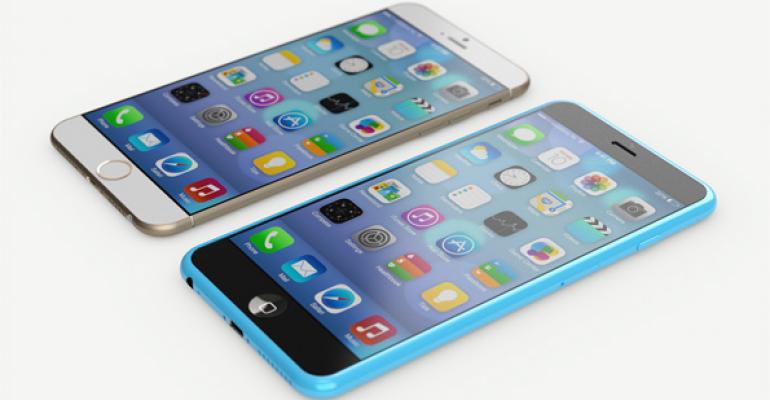There's a growing consensus that when—when, not if—Apple releases an iPhone with a reasonably-sized screen, it will be game over for the Android horde. But one of the original, wrong-headed design goals of the iPhone makes a big screen iPhone difficult if not impossible. And I'm curious to see how Apple overcomes this.
I've been thinking lately about how these larger phones are transforming the smart phone market specifically, and mobile devices more generally. Check out Can a Lumia 1520 Replace a Tablet? for another example of this kind of exercise in thinking out loud.
Today, Apple's flagship iPhone 5S looks like a miniature replica of a smart phone compared to more reasonably sized phones like the Nokia Lumia Icon or Samsung Galaxy S5.

Even the two bigger phones here aren't technically phablets
(When I was taking this picture my wife walked in and said, unprompted, "Ah, how cute. It's like a mini phone!")
Apple is allegedly prepping one or two new iPhone models, both with large screens. I've seen rumors about a 4.7-inch version and one that is over 5 inches big; the latter would qualify as a phablet. Whatever it does, this isn't the first time Apple's been on the wrong end of market trends: It's iPad mini, while excellent, was a response to the fastest-growing part of the tablet market, that for mini-tablets. A market that was created by its Android competitors. The same thing is happening now with smart phones.
It's not hard to imagine an iPhone with a roughly 5-inch screen, and while I don't recommend doing so, you can visit any number of Apple fanboy sites to see a growing selection of user-created mock-ups, not to mention supposedly authentic case designs. Whatever: Blowup an iPhone 5S to about 1.25x its normal size and there it is. An iPhone 6.
There's just one problem: Thanks to Steve Jobs' insane hatred of buttons—which also led to a single-button Mac mouse, among other shortsighted design decisions—the iPhone doesn't have a back button. And this means that "back" functionality has to be implemented in software. While some apps do their own thing here, most place a Back button in the upper left corner of the screen.
This design led to the iPhone 5/5S/5C, which are taller but not wider than previous iPhones. The reason? If the screen was wider, it would be impossible for most people to hit that Back button while using the device in the normal single-handed mode. On bigger Android and Windows Phone handsets, there's no worry about such a thing, because they all include easily accessible hardware Back buttons.
This taller iPhone design has gotten Apple by for two years. But with phablets and large-screen devices now making up the fastest-growing and most profitable parts of the smart phone market, it's no wonder that the firm, finally, is looking to release at least one big screen iPhone of its own.
I'm just curious how they're going to overcome that Back button thing.
I know from using an iPad mini that its current onscreen placement makes it awkward to use. In the Kindle app I use most frequently, for example, you can tap in the middle of the screen to bring up the app's Spartan UI, but then you have to reach all the way up to the upper left corner of the screen to access the menu. (Basically, Back.) Ditto for the Back button in Safari. And so on.
Will Apple add a Back button to its devices? I doubt that. But maybe it's time for a rethinking of some core iOS user interface elements and design norms now that the dust has settled on the iOS 7 look and feel controversies. Maybe it's something as simple as implementing "back" as a leftward swipe from the right edge of the screen, a move that would also free up some onscreen real estate since all those software Back buttons would no longer be necessary.
I don't know. I just know they're going to have to address this. And the answer can't be, "just use two hands."





